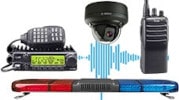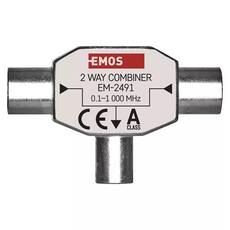- Special Offers
- Transceiver Radio
- Transceiver Accessory
- Antennas
- Antenna Accessory
- Antenna Rod and Radiator
- Magnet Mount for Antenna
- Drillable Antenna Base
- Antenna Mounting Bracket
- Antenna Mast and Fitting
- Antenna Switch and Coax Switch
- SWR Meter, Antenna Tuner
- Antenna Surge Suppressor
- Grounding Clamp for Coax Cable
- Antenna Rotator and Motor Driven Antenna Mount
- Antenna Dummy Load
- WiFi Antenna Splitter and Coupler
- Wingscrew
- Antenna Meter
- TV Antenna Splitter
- Multiswitches
- TV Antenna Combiner
- TV Antenna Amplifier
- LNB Head for Satellite Dish
- TV Headend
- Cable
- Connector
- Installation Material
- Installation Tools
- Measuring Equipement
- Body Worn Camera
- Electrosmog
- Telephone
- Baby Monitor
- Fever Thermometer
- Radio Device
- Set-top Boxes
- Personal Protective Equipment
- Motorcycle Helmet Speaker
- Car Equipment
- Voltage Converter
- Dry Cell
- Battery
- Battery Charger
- Emergency Signal
- Amber Signal
- Sound Signal
- Light and Sound Signal Accessory
- Traffic Engineering
- LED Lamp
- Smart Home
- Mosquito Repellent Device
- Market - Other Products
- Discontinued Products
Pre-order (1)
TV Antenna Combiner
The TV antenna combiner combines terrestrial television broadcasting with the signal from the satellite, i.e. it allows the introduction of two signals from two different antennas into one end point. Thanks to the TV combiner, the two signals can be used on one receiver, i.e. one television set, without any additional equipment. This eliminates the need for two TVs to watch different channels from different antennas. The antenna combiner feeds the TV signals from the two antennas into the TV set via a coaxial cable. Read more...
Pre-order (1)
• Type: universal ferrites
• Number of inputs: 2
• Number of outputs: 1
• Connector type: IEC
• IP20 protection
• Frequency range: 0,1-1 000 MHz
• Lamp body: zinc die-cast
• Usage: TV + R
• Insertion loss: 3,5 dB
• Dimensions: 17 × 32 × 23 mm
A TV antenna combiner, also called a diplexer
There are some diplexers that can be placed outdoors, but in this case they must be protected from bad weather conditions. Therefore, we have to place them in a specially designed so-called drip-proof box. The advantage of this is that in this case the TV antenna connector can be placed near the installed antennas, i.e. near the satellite dish and the ground rooftop antenna. But with the Tv common, it is also possible to separate the signals, but in the opposite way. For ideal combining, make sure that both signals are approximately the same at the input.
What are the specifications of the Tv antenna combiner?The type of connector you will need is the F socket, the Tv frequency range is 5-860 MHz, the SAT frequency range is 950 - 2150 MHz, and the band separation attenuation is 20 dB and the attenuation is 3 dB.
The TV antenna combiner is not an antenna splitter
I am sure that many of us have tried to distribute the TV signal from the digital terrestrial antenna between several TV sets, since nowadays in apartments and family houses there are TV sets in several rooms. How is this technically possible? Cable TV providers are contracted to provide a signal strength that can be shared between two or three, or even four receivers without any problems. If you want to distribute the terrestrial digital signal to more than that, you will need to install one or possibly more antenna splitters, or possibly a cable TV amplifier.
Dividing the incoming TV signal is a very simple process, but you need to be careful about the type of broadcasting you are using. It makes a difference whether you want to share a digital terrestrial (DVB-T/T2) or satellite (DVB-S/S2) signal. For digital terrestrial signals, a simple two-way antenna splitter can solve the problem. In contrast, a TV antenna splitter does not split the incoming signal between the two ends, but provides convenience by routing the signal from two different antennas into one input cable. This allows you to enjoy both cable TV and satellite TV channels on one TV.
Terrestrial and SAT antennas, or only terrestrial reception?
The diplexer combines the signals from the terrestrial and SAT antennas into a common input cable, i.e. the TV combiner allows you to watch all the MinDig TV and satellite broadcasts on one TV. So it's not just terrestrial digital programmes that can be combined with a TV antenna combiner.
Active and passive TV antenna combiner
The basic difference between active and passive TV antenna combiners is that active combiners have a built-in amplifier, while passive combiners do not.
Passive TV antenna combiners
These devices contain no electronic components to amplify the antenna signal. Because they do not require a power supply, they are easier to install and do not depend on a nearby electrical outlet. Passive combiners simply combine the signal from different antennas and put it on one output. It is important to note that if the signal from the antennas is already weak, a passive TV antenna combiner will not be an ideal solution, as each combiner will reduce the signal level by 2-3dB. They are mostly beneficial in smaller systems or where reception is strong.
Passive TV antenna combiners (with amplifiers)
These devices are used to amplify the antenna signal, thus improving the quality of TV reception, especially over longer cable distances and with multiple antennas. They require power, which is usually provided by a separate adapter, or in some devices they can be powered via the coaxial cable. Active repeaters can help to improve picture quality if the signal is weak or the output signal is not strong enough. However, if the incoming signal is already at a high level, these amplifiers can cause distortion or over amplification, which can have a negative impact on reception quality.
When deciding whether to use an active or passive repeater, it is important to consider the strength of the signal received by the antenna, the length of the cable, and how many devices the signal will need to be distributed to. If you are unsure about the right type, our company is at your service!


